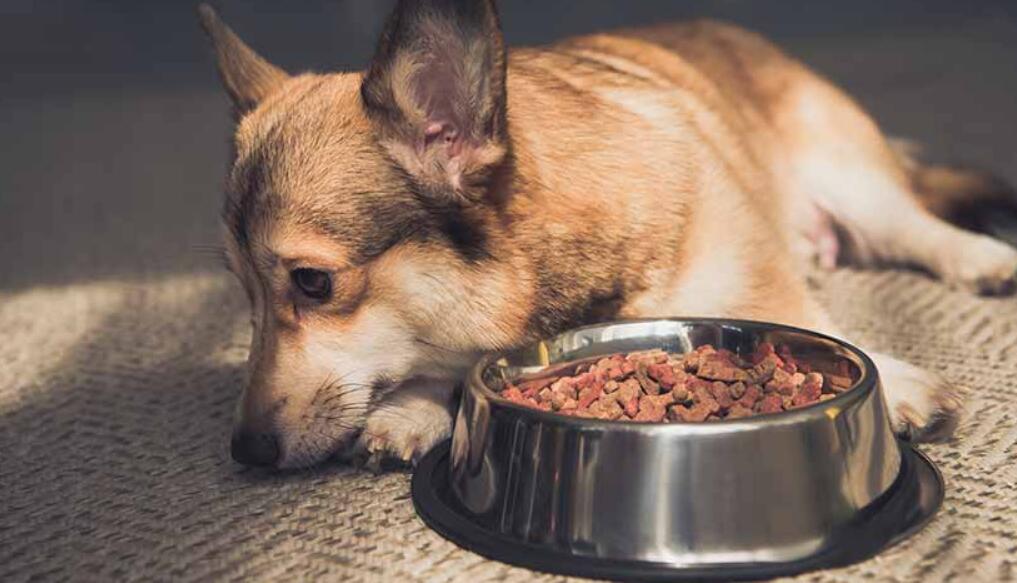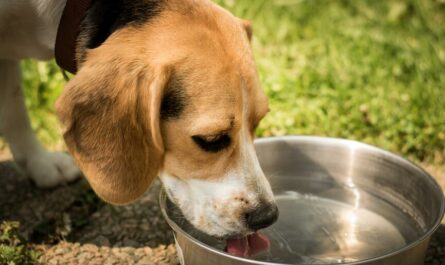If you’re a dog owner, you know that your furry friend is always hungry. But what happens when your dog suddenly stops eating? How long can a dog go without eating? The answer to this question is not straightforward and depends on several factors, including your dog’s individual health, activity level, and environment.
Generally, most dogs can go three to five days without eating before they experience any serious health consequences, as long as they are still drinking water. However, it’s essential to keep a close eye on your dog’s eating habits and take action if they refuse food for more than two meals.
If your dog is not eating and drinking water, you should contact your veterinarian immediately as it could be a sign of a severe health issue. In this article, we will explore the topic of how long a dog can go without eating and provide some tips on how to encourage your dog to eat if they are not feeling well.

Understanding Dog’s Eating Habits
As a dog owner, it is important to understand your dog’s eating habits to ensure they are healthy and happy. Here are some things to keep in mind:
Puppies and Meals
Puppies have smaller stomachs than adult dogs, so they need to eat smaller meals more frequently throughout the day. Generally, puppies should eat three to four times a day until they are six months old. After six months, you can start to transition them to two meals a day.
Appetite Changes
Dogs may experience changes in their appetite due to a variety of factors, such as illness, stress, or changes in their environment. If your dog suddenly loses their appetite, it is important to monitor them closely and contact your veterinarian if they go more than a day without eating.
Healthy Dogs and Meals
Most healthy dogs can go up to five days without eating, as long as they have access to water. However, it is important to note that going without food for extended periods of time can lead to nutritional deficiencies and other health problems. It is important to ensure your dog is getting proper nutrition through a balanced diet.
Dog’s Appetite and Nutrition
A dog’s appetite can be a good indicator of their overall health. If your dog is consistently refusing food or eating significantly less than usual, it may be a sign of an underlying health issue. It is important to monitor your dog’s eating habits and contact your veterinarian if you notice any significant changes.
Signs of Loss of Appetite in Dogs
As a dog owner, you know that your furry friend’s appetite can be a reflection of their overall health. A healthy dog will typically have a good appetite, while a dog that is not eating may be showing signs of an underlying issue. Here are some signs of loss of appetite in dogs that you should be aware of:
Decreased Appetite
A dog that is not eating as much as usual or has completely stopped eating may be experiencing decreased appetite. This can be a sign of an upset stomach, dental problems, or other medical conditions. If your dog has decreased appetite for more than a day, it is important to call your vet and schedule a check-up.
Lethargy
A dog that is not eating may also show signs of lethargy, which is a lack of energy or enthusiasm. This can be a sign of anxiety, dehydration, or other medical conditions. If your dog is lethargic and not eating, it is important to seek veterinary care.
Upset Stomach
An upset stomach can cause a dog to lose their appetite. Signs of an upset stomach include vomiting, diarrhea, and excessive gas. If your dog is experiencing an upset stomach and not eating, it is important to monitor their symptoms and seek veterinary care if necessary.
Dental Problems
Dental problems can also cause a dog to lose their appetite. Signs of dental problems include bad breath, bleeding gums, and difficulty chewing. If your dog is experiencing dental problems and not eating, it is important to schedule a dental exam with your vet.
Medical Conditions
There are several medical conditions that can cause a dog to lose their appetite, including hypoglycemia, coughing, and other illnesses. If your dog has a medical history or is showing signs of appetite loss, it is important to schedule a physical exam with your vet and keep up with their vaccinations.
Common Causes of a Dog Not Eating
It can be concerning when your furry friend refuses to eat their food. There are many reasons why a dog may not want to eat, ranging from minor issues to more serious medical conditions. Here are some common causes of a dog not eating:
Stress
Just like humans, dogs can experience stress. Stressful situations such as moving to a new home, changes in routine, or the addition of a new pet or family member can cause a dog to lose their appetite. If you suspect stress is the cause of your dog’s lack of appetite, try to create a calm and predictable environment for them.
Picky Eater
Some dogs can be picky eaters and may turn their nose up at their food. This can be due to the taste, texture, or smell of the food. If your dog is a picky eater, try offering different types of food or adding some flavor to their food to entice them to eat.
Medical Issues
There are many medical issues that can cause a dog to lose their appetite. Dental problems, such as tooth decay or gum disease, can make it painful for a dog to eat. Other medical issues that can cause a dog not to eat include infections, nausea, and medication side effects. If your dog’s lack of appetite persists, it’s important to take them to the vet to rule out any underlying medical issues.
Vomiting and Diarrhea
If your dog is experiencing vomiting or diarrhea, they may not want to eat. These symptoms can be caused by a number of things, including food allergies, infections, or parasites. If your dog is vomiting or has diarrhea, it’s important to monitor their symptoms and make sure they stay hydrated. If the symptoms persist, take them to the vet.
Effects of a Dog Going Without Eating
If your furry friend is not eating, it can be a cause for concern. Dogs can go without food for a few days, but it’s not ideal for their health. Here are some effects of a dog going without eating:
Dehydration
When a dog doesn’t eat, they are also likely not drinking enough water. Dehydration can occur quickly and can lead to serious health problems. Make sure your dog has access to fresh water at all times, and encourage them to drink.
Weight Loss
If your dog is not eating, they will start to lose weight. This can be dangerous, especially for older dogs or dogs with underlying health issues. Rapid weight loss can lead to muscle wasting and weakness.
Kidney Disease
If your dog is not eating, they are not getting the nutrients they need to stay healthy. This can lead to kidney disease, which can be life-threatening. If your dog is not eating, it’s important to take them to the vet to rule out any underlying health issues.
Diabetes
If your dog has diabetes, not eating can be especially dangerous. Dogs with diabetes need to eat at regular intervals to maintain their blood sugar levels. If your dog is not eating, their blood sugar levels can drop dangerously low.
Dying
If a dog goes too long without eating, they can die. It’s important to monitor your dog’s eating habits and take action if they are not eating for an extended period of time.
What to Do When Your Dog Won’t Eat
It can be concerning when your furry friend refuses to eat, but there are a few things you can do to help entice them back to their food bowl.
Check Their Water Supply
Make sure your dog has access to plenty of fresh water at all times. Encourage them to drink by adding ice cubes or a water fountain to their bowl. Dehydration can cause a loss of appetite, so keeping your pup hydrated is important.
Offer Treats
Try offering your dog some of their favorite treats to see if that sparks their appetite. Just be careful not to overdo it, as too many treats can upset their stomach.
Contact Your Vet
If your dog continues to refuse food for more than a day or two, it’s time to contact your vet. They can help determine if there’s an underlying medical issue causing the loss of appetite.
Entice with Wet Food or Broth
If your dog typically eats dry food, try offering them wet food or adding some low-sodium broth to their meal. The extra moisture can help entice them to eat.
Microwave Their Food
Heating up your dog’s food in the microwave for a few seconds can help release the aroma and make it more appealing to them.
Try Baby Food or Meat
In some cases, adding a small amount of baby food or cooked meat, such as chicken breast, can help stimulate your dog’s appetite. Just be sure to avoid any seasonings or ingredients that could upset their stomach.
Stick to a Schedule
Establishing a regular feeding schedule can help your dog get into a routine and feel more comfortable with mealtime.
Consider an Appetite Stimulant
If your vet determines that there’s no underlying medical issue causing your dog’s loss of appetite, they may recommend an appetite stimulant to help get them eating again.
Consider White Rice
If your dog is experiencing GI upset, feeding them a small amount of cooked white rice can help settle their stomach and encourage them to eat.
Dietary Considerations for Dogs
Dogs need food and water to survive, and it is important to ensure that they are getting the proper nutrition they need. Older dogs and dogs with sensitive stomachs may require special diets or smaller portions to avoid digestive issues. If you suspect that your dog’s diet is causing the problem, consider making changes to their food or feeding routine.
When introducing new foods to your dog, it is important to do so gradually to avoid upsetting their stomach. Start by mixing a small amount of the new food with their current food and gradually increase the amount over several days. You can also try adding flavor to your dog’s water to encourage them to drink more.
Canned dog food can be a good option for dogs with sensitive stomachs or those who are picky eaters. Canned food tends to be more palatable and easier to digest than dry kibble. However, it is important to ensure that your dog is still getting all the necessary nutrients from their diet.
In new surroundings, your dog may be hesitant to eat due to stress or anxiety. Try to make their new environment as comfortable as possible and maintain their regular feeding routine. If your dog is still not eating, try offering them small, frequent meals throughout the day rather than one large meal.
Conclusion
In conclusion, it is important to understand that dogs can go without food for a few days as long as they have access to water. However, it is not recommended to let your dog go without food for more than two days. If your dog is not eating and showing signs of illness such as vomiting or diarrhea, it is important to seek veterinary care immediately.
As a pet owner, it is your responsibility to ensure that your dog is getting the proper nutrition they need to stay healthy. This includes providing them with a balanced diet that meets their nutritional needs based on their age, weight, and activity level.
It is also important to monitor your dog’s weight and body condition regularly to ensure that they are not becoming overweight or underweight. If your dog is overweight, it is important to work with your veterinarian to develop a weight loss plan that includes a healthy diet and regular exercise.





